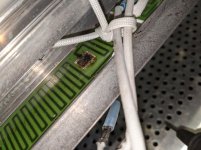I need to reflow the solder around a heating element contact for a hot laminator shoe, but my soldering iron is not melting the solder. Pretty strange as I've not seen this issue before. Is there a higher temp solder than normal that might have been used in this application? The heating element is on a PC board and bonded to the shoe with silicone, and designed for 300F working temp, so presumably it would never go over 500F which I'm told is the max for silicone. Is there such a thing as high temp solder for electronics?




